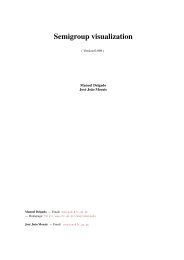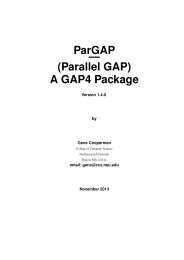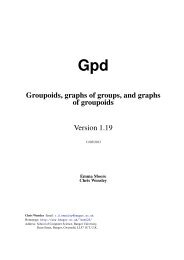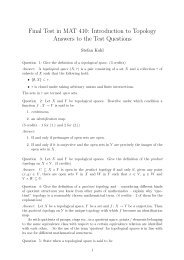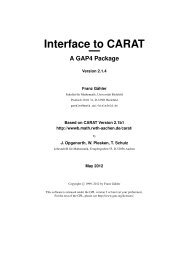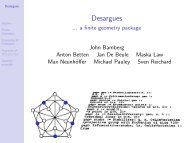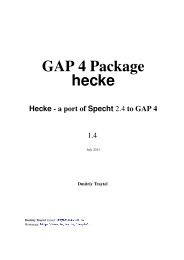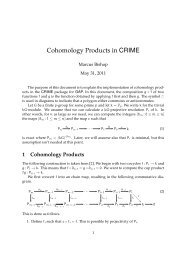guava - Gap
guava - Gap
guava - Gap
Create successful ePaper yourself
Turn your PDF publications into a flip-book with our unique Google optimized e-Paper software.
GUAVA 16<br />
gap> C1:=ElementsCode(m, GF(2));<br />
a (6,8,1..6)2..3 user defined unrestricted code over GF(2)<br />
gap> IsLinearCode(C1);<br />
false<br />
gap> WeightDistribution(C1);<br />
[ 1, 0, 0, 6, 0, 0, 1 ]<br />
In this example we first wrote out a list of strings, then converted them into codewords over<br />
GF(2). The call to ElementsCode constructs a code from a list of elements. It is possible that the set<br />
of codewords we used actually is a vector space, but the call to IsLinearCode says no. Finally the<br />
last function tells us that there are 6 codewords of weight 3, and one each of weights 0 and 6 in this<br />
code.<br />
A very useful feature of GUAVA is the ability to construct random codes:<br />
Example<br />
gap> C:= RandomLinearCode(12,5,GF(2));<br />
a [12,5,?] randomly generated code over GF(2)<br />
An error-correcting code’s properties are fairly well captured by three numbers which traditionally<br />
are referred to using the letters n, k and d. We ask for a random code by specifying n (the wordlength),<br />
and k (the code’s dimension) as well as the field which serves as the alphabet for the code.<br />
One of the most salient features of a code (a feature that determines how good it will be at correcting<br />
errors) is its minimum weight, d. This is the smallest weight of any nonzero word in the code.<br />
If we wish to correct m errors we will need to have a minimum weight of at least 2m + 1.<br />
Example<br />
gap> MinimumWeight(C);<br />
3<br />
This particular code would be capable of correcting single bit errors.<br />
Finally, one might be interested in the entire distribution of the weights of the words in a code.<br />
The weight distribution is a vector that tells us how many words there are in a code with each possible<br />
weight between 0 and n.<br />
Example<br />
gap> WeightDistribution(C);<br />
[ 1, 0, 0, 2, 3, 6, 7, 6, 4, 2, 1, 0, 0 ]



